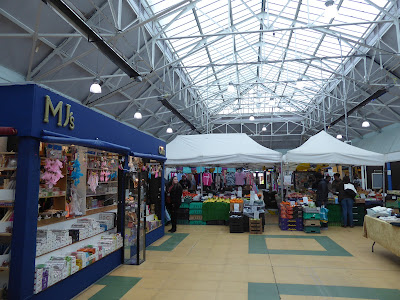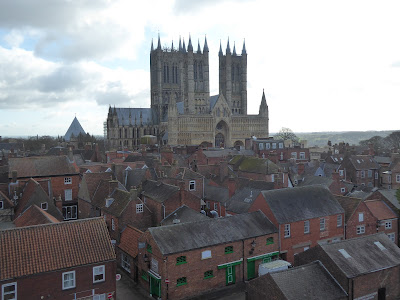After looking round the castle in the morning, I decided to walk down the hill into the main town. It is very steep and with a name like 'Steep Hill' you can't expect anything else.

I wandered around taking lots of photos of interesting buildings. I haven't got a guide book so unless there was an information board nearby I had no idea of the building's history.
At the bottom of the hill you go through this archway which leads to the larger modern shopping areas.

The Stonebow or stone archway over the High Street dating from late 15th-early 16th century. It is part of the Guildhall and stands where the Southern gate to the old Roman City once stood. The Guildhall has been used since its construction in 1520 and is still used today for council meetings.


The centre of the town was much bigger than I had thought - lots of different shopping areas.
The River Witham flows through the centre of Lincoln.
This iis the Empowerment sculpture which straddles the river.
The cast aluminium turbine blades change into figures that reach out to one another. It was made in celebration of the Millennium.
This is the central market which opened just before the war in 1938.
This large, impressive building is Lincoln railway station. It was built in 1848 in the Tudor revival style.
The trains travel to and from London as well as other cities. I was surprised that there was a level crossing for the trains going in and out of the station. I don't recall ever seeing that in a city before.
The barrier came down just after I had crossed so I waited to see the inter city train on its way into the station.
Just before the level crossing the train lines go over the river which is looking very high. On my journey to Lincoln I saw a few fields still underwater from the floods we had just a few weeks ago.
The river flows into Brayford Waterfront. In the 18th and 19th centuries Brayford Pool was an important inland port. The banks of the pool were lined with warehouses, flour mills, silk mills, granaries and breweries. By the 1870s this was all coming to an end when the railway came to Lincoln. The railways could transport people and goods faster than any boat and it wasn't long before the boat companies were put out of business.
In the 1960s the pool was saved from becoming a car park and much development took place. Nowadays you have Lincoln University on one side of the pool and on the other there are numerous restaurants, bars and hotels.

In 1972 Wigford Way bridge was constructed over the river. Prior to that a swing bridge existed.
I followed the river to the High Bridge.
Gruesome character looking out of a window overlooking the bridge!
High Bridge is known to locals as the 'Glory Hole'. It was built about 1160 and is said to be the oldest bridge in the country with buildings on it. Two centuries ago the bridge caused great difficulties for boats using the River Witham. The river here is shallow, making it hard for boats to cross the high riverbed, so goods had to be unloaded in the Brayford, carried under the bridge by small boats called 'lighters' then reloaded onto bigger ships in deeper water.
Further along the river is The Witch and Wardrobe pub, another of the old buildings still standing in the city centre. Initially built in the 13th century. The buildings exterior was an extension built in the 15th century.
I decided it was time to walk back up Steep Hill. I stopped to take photos of some of the more interesting shops.
 One tea shop caught my eye 'Bunty's'. My Mum was always known as Bunty by her Scottish relatives. She had been given the name by her Granny and it stuck. I didn't need much encouragement to go in and sample the tea and scones.
Mum would definitely have approved of the china tea set and the warm scone with homemade raspberry jam. I asked the owner where the name had come from but she didn't know as it had been named by the previous owner. She thought it might have had a connection to the popular girl's comic in the 50s which was called 'Bunty'
One tea shop caught my eye 'Bunty's'. My Mum was always known as Bunty by her Scottish relatives. She had been given the name by her Granny and it stuck. I didn't need much encouragement to go in and sample the tea and scones.
Mum would definitely have approved of the china tea set and the warm scone with homemade raspberry jam. I asked the owner where the name had come from but she didn't know as it had been named by the previous owner. She thought it might have had a connection to the popular girl's comic in the 50s which was called 'Bunty'
Finally I was back in the Cathedral quarter. This time I walked around the other side of the mighty Cathedral. I would be moving on in the morning and I just wanted one final look.
To the right of the Cathedral is this passageway leading to the remains of the medieval Bishop's Palace.
Behind this is the converted church where I was staying.

I walked back up to the Cathedral and onto the green. Minster Yard is the are immediately surrounding the Cathedral. Together with a number of nearby streets it was enclosed within a defensive wall in the 14th century. The area was known as Cathedral close. The green are in front of the houses was once the graveyard of St Margaret's church dating back to the early 11th century.
At the end of the Close is Pottergate, one of the gates built in the 14th century to defend the cathedral. It was locked every night until the 1700s. A lot of the adjacent wall and houses were demolished in the 1800s to make way for a wider road.

I wandered around taking lots of photos of interesting buildings. I haven't got a guide book so unless there was an information board nearby I had no idea of the building's history.
At the bottom of the hill you go through this archway which leads to the larger modern shopping areas.

The Stonebow or stone archway over the High Street dating from late 15th-early 16th century. It is part of the Guildhall and stands where the Southern gate to the old Roman City once stood. The Guildhall has been used since its construction in 1520 and is still used today for council meetings.


This iis the Empowerment sculpture which straddles the river.
The cast aluminium turbine blades change into figures that reach out to one another. It was made in celebration of the Millennium.
This large, impressive building is Lincoln railway station. It was built in 1848 in the Tudor revival style.
The trains travel to and from London as well as other cities. I was surprised that there was a level crossing for the trains going in and out of the station. I don't recall ever seeing that in a city before.
The barrier came down just after I had crossed so I waited to see the inter city train on its way into the station.
Just before the level crossing the train lines go over the river which is looking very high. On my journey to Lincoln I saw a few fields still underwater from the floods we had just a few weeks ago.

In 1972 Wigford Way bridge was constructed over the river. Prior to that a swing bridge existed.
I followed the river to the High Bridge.
Gruesome character looking out of a window overlooking the bridge!
High Bridge is known to locals as the 'Glory Hole'. It was built about 1160 and is said to be the oldest bridge in the country with buildings on it. Two centuries ago the bridge caused great difficulties for boats using the River Witham. The river here is shallow, making it hard for boats to cross the high riverbed, so goods had to be unloaded in the Brayford, carried under the bridge by small boats called 'lighters' then reloaded onto bigger ships in deeper water.
Further along the river is The Witch and Wardrobe pub, another of the old buildings still standing in the city centre. Initially built in the 13th century. The buildings exterior was an extension built in the 15th century.
 One tea shop caught my eye 'Bunty's'. My Mum was always known as Bunty by her Scottish relatives. She had been given the name by her Granny and it stuck. I didn't need much encouragement to go in and sample the tea and scones.
One tea shop caught my eye 'Bunty's'. My Mum was always known as Bunty by her Scottish relatives. She had been given the name by her Granny and it stuck. I didn't need much encouragement to go in and sample the tea and scones.Finally I was back in the Cathedral quarter. This time I walked around the other side of the mighty Cathedral. I would be moving on in the morning and I just wanted one final look.
To the right of the Cathedral is this passageway leading to the remains of the medieval Bishop's Palace.
Behind this is the converted church where I was staying.

I walked back up to the Cathedral and onto the green. Minster Yard is the are immediately surrounding the Cathedral. Together with a number of nearby streets it was enclosed within a defensive wall in the 14th century. The area was known as Cathedral close. The green are in front of the houses was once the graveyard of St Margaret's church dating back to the early 11th century.
At the end of the Close is Pottergate, one of the gates built in the 14th century to defend the cathedral. It was locked every night until the 1700s. A lot of the adjacent wall and houses were demolished in the 1800s to make way for a wider road.
I have really enjoyed my time in Lincoln but it's now time to enjoy one last evening in the converted church B and B and hope that the next place I am staying is equally as interesting.



































































